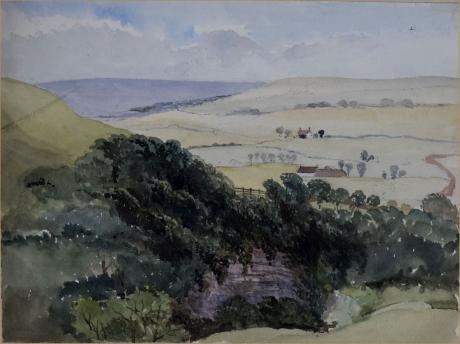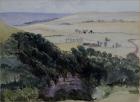inscribed and dated in the margin " View from The Gilsand Hotel, Northumberland / 1866"
Gilsland Spa is the present-day name of a hotel at Gilsland, Cumbria, England. It is named from the sulphurous spring which issues from a cliff below the hotel.
The original hotel was called The Shaws, from an Old English word meaning a small woodland, and was built in the 1760s, although the site and its surrounding farmland have been known by this name since at least 1603. Lord William Howard's map of the Barony of Gilsland of this date shows two buildings near the site of the hotel labelled "Two tenements called the Shaws". Very little is known about the first hotel but one contemporary drawing suggests that it may have had a tower in imitation of the type of fortified house known locally as a peel.
This original Shaws Hotel burned down spectacularly in 1859, and was replaced on a grander scale soon afterwards by G. G. Mounsey, a local landowner and first elected mayor of Carlisle. Around this time, Rose Hill railway station was renamed Gilsland, and the surrounding collection of hamlets became the village of Gilsland, but the hotel continued to be called The Shaws until it was leased to the Gilsland Spa Hotel and Hydro Company of South Shields in 1893. Expensive renovations, including an improved water supply, crippled this company financially, and it failed in 1900. The Co-operative Wholesale Society took over in 1901 to run it as a convalescent home, the Co-operative Group being principal shareholders in the business. The present-day management welcome the use of its large car park by visitors wishing to enjoy the dramatic wooded gorge, and offer food, drink and accommodation. Gilsland Spa has a sister hotel, The Esplanade, in Scarborough, Yorkshire. The two hotels were sold by the Co-op in December 2017 and the new owners Northern Powerhouse Developments planned major refurbishments.
The hotel has been a popular resort since the eighteenth century. Susanna Blamire, the Cumbrian Muse, came to take the waters in the later part of the century and Walter Scott came here in "the season" of 1797 looking for a wife, and found one. The opening of the railway station in 1836 galvanised the village and during the later part of the 19th century and the early 20th, Gilsland was thronged with tourists, many of whom were working-class people from Tyneside. Reviewers of the hotel repeatedly stressed the free and easy way in which the different classes mixed. One of the main attractions, though for reasons no-one is prepared to admit, has been the Popping Stone, an enigmatic stone some half a mile from the hotel in a secluded glade, linked to various courtship and fertility rituals. Next to the stone was the Kissing Bush, an ancient hawthorn which died in the 1940s. These relics and two mineral springs (sulphurous and chalybeate) are situated along the network of wide footpaths known as the Home Walks which provide access to the rugged scenery of the hotel grounds. During its time the hotel has been a First World War military convalescent home and a Second World War maternity hospital and was known locally until recently as "The Home".
Gilsland is a village in northern England about 20 miles (32 km) west of Hexham, and about 18 miles (29 km) east of Carlisle, which straddles the border between Cumbria and Northumberland. The village provides an amenity centre for visitors touring Hadrian's Wall and other features of historical interest in this area of rugged Border country, popularised by the Romantic novelist Sir Walter Scott.
Its unusual arrangement of incorporating two county councils and three civil parish councils is due to the gradual amalgamation of hamlets during the 19th century. It has a population of about 400, most of whom live on the Northumberland side of the River Irthing and Poltross Burn.
As in most areas of Britain, Bronze-Age and Iron-Age settlement in Northumberland is represented by cup and ring marked stones, standing stones and hill forts, though few such monuments, with the possible exception of the Popping Stone, have been found near Gilsland. Recent field-walking activities by a local archaeology group have produced flint artefacts dated to the Bronze Age and Neolithic. The evident antiquity of the civil parish boundaries may also be traceable to the Iron Age.
Gilsland is situated upon Hadrian's Wall, a noted monument constructed by the Roman army in the early part of the second century AD and lately listed as a World Heritage Site. The major Roman fort of Birdoswald lies a couple of miles to the west of Gilsland. The Wall itself was initially of turf from a point to the west of Gilsland, but was eventually replaced in stone.
During the 12th century the area now known as Cumbria passed from the control of the Kingdom of Strathclyde to the English King Henry II. This region was subdivided into baronies, the easternmost of which became the Barony of Gilsland, apparently named after an individual, although sporadic speculation by historians has failed to conclusively identitify him. This barony was ruled by Lord William Howard during the 16/17th century and stretched from Carlisle to the present-day village of Gilsland. Gilsland Spa, a locally renowned mineral spring, was named from the Barony and the name was transferred from there to the village, although most of the population live on the Northumberland side, outside the original borders of the Barony.
The ancient kingdoms of Strathclyde and Northumbria were eventually subsumed into what we now know as Scotland and England, but for most of the later mediaeval period the Borders suffered instability and lawlessness due to their mutual antipathy and the indeterminate nature of the border. There have been many valiant attempts to romanticise the assumed incessant violence, starting with Sir Walter Scott, who visited Gilsland and got engaged at the Popping Stone.
As soon as the area was definitively pacified, with the Union of the Crowns and the suppression of the 1745 Jacobite rebellion, economic activity rapidly increased. The original Gilsland Spa hotel was built in the 1760s, was already a popular summer resort by the 1780s and went on to provide a nucleus for the accumulation of guest-houses we now recognise as Gilsland. The opening of a railway station in 1836 led to a boom in tourism. In the 1860s the name of the station was changed from Rose Hill to Gilsland, and residents of Rosehill, Mumpshall, Crooks, The Gap and surrounding farms and hamlets were invited to think of themselves as a single village, the name having been derived from the surrounding Barony of Gilsland.
Today the village is somewhat isolated, as it always has been, with large tracts of forestry and high ground – laced with popular public footpaths, cycle trails and bridleways – to the north and south. The A69 east-west trunk road runs nearby, providing access to Hexham and Carlisle within half-an-hour by car, or the closer towns of Haltwhistle and Brampton in minutes. Bus services are plentiful from Easter to October with the AD122 service (a reference to the date Hadrian commenced the wall) running every 2 hours. In the winter months Gilsland is less well served by bus services, and the railway station has been closed for many years but there is now a campaign to reopen it. Following cuts by Carlisle City Council the village has had a further 2 buses, owned by Arriva and Stagecoach, removed from the bus schedule and only 2 buses a day are now guaranteed.
In the recent past, several small coalmines operated nearby, but occupation has mainly been in farming and building trades, also haulage, and a white-lining business is located in the village. Funding is currently being invested in the development and promotion of the area for tourism, and residents are increasingly offering flourishing 4 and 5-star rated B&B and Guest House accommodation. Some 100 local people earn part or whole of their living from tourism. Hadrian's Wall Heritage Limited – the body charged with maintaining the World Heritage Site corridor – estimate that visitor numbers (already circa 400,000 per annum) are set to rise 8% per annum over the next 3 years, which could be problematical, considering that current numbers are already causing damage to the main attraction.


